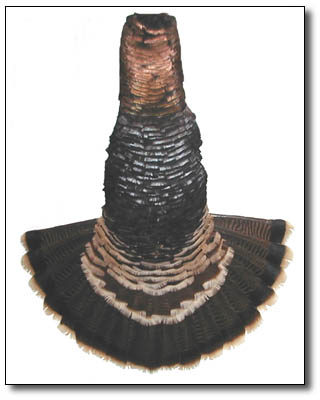| |
| Wild
Turkey Hunting Articles -- |
|
How
to Make a Cape Mount
--
by Rob Ramsdale --
 |
|
Cape Mount of a Rio Grande
Turkey
|
If you want to save a
cape mount like the one shown in the picture, here
are the basic steps to follow.
- Hang the turkey by its head and
begin skinning out the back of the turkey by starting
high on its neck where the feathers begin. If you've
ever plucked a turkey, you know that a turkey's
feathers are laid out in tracts and not every inch
of skin has feathers coming out of it. For a cape
mount, you want to remove the tract of feathers
that run in about a 3" wide strip down the turkey's
back. You can see a part in the feathers if you
look closely and once you start skinning down the
back of the bird you can see it's a very thin strip
of skin that contains all the feathers that cover
the back and even down the sides of the turkey.
- Carefully skin the bird's back
all of the way down to the tail and then cut down
through the base of the tail to remove the tail
with the back skin still attached.
- Lay the cape off to the side and
finish dressing the bird.
- Once you have the bird cleaned,
go back to the cape and start by scraping all of
the flesh off the skin and then proceed to the tail.
- The tail fan takes some time to
get clean. You want to remove all of the flesh and
fat possible by cutting or scraping with a knife
and even using a wire brish to get down between
the feather quills. You also need to remove the
piece of the backbone that is still attached to
the tail. A pair of pliers will help you twist the
tailbone out which will allow the tail fan to lie
flat.
- After the cleaning is complete,
you have the option of washing the cape if the feathers
got dirty or were messed up on the tips. If you've
ever shot a bird that rolled down a mountain or
shot one in the rain you know that often the tail
feathers are a ragged mess when you get to the bird.
They can be fixed, as long as they aren't broken,
by simply washing them. Start by dunking the cape,
tail feathers and all, into a tub or sink of warm
water that has Dawn or some other mild grease-cutter/cleanser
mixed in with it. Swish the cape and feathers around
really well and work any noticeable dirty or greasy
spots on the cape with your fingers. It's amazing
how much dirt the turkey feathers can be carrying
and a good wash and clean water rinse will really
make your feathers shine. After the cape is rinsed,
you can use a hair dryer set on low to gradually
dry and fluff the feathers. I don't own a hair dryer
so I generally pin the cape up in front of a fan
and just let it dry that way. It doesn't take long
and I check it once in awhile and help get the feather
"combed" back neatly but running the feathers through
my finger tips. If you kept really good care of
the feathers on your way in from the field, you
can often skip this step.
- After the feathers are dry, rub
the entire bare skin and tail section with borax
(You can use 20 Mule Team Borax which is a laundry
additive you can find at WalMart.) Don't skimp on
the borax since it will help dry the skin and preserve
it so the bugs won't attack it.
- Take the treated skin and lay it
skin-side down on a board or stiff piece of corrugated
cardboard. Work your way around the fan pinning
the feathers into the position you want them to
dry in. This is one place you can actually cover
up a broken or missing tail feather by spacing the
rest of the feathers out enough to cover the extra
space.
- The cape should be check periodically
during its drying period of around 3 - 5 weeks.
You may need to add more borax during this time.
- Once it's dry, remove the pins
and shake off any excess borax. If you like, you
can cut a piece of wood or felt to further mount
the cape on.
I hope this will help
you create a lasting memory of your favorite turkey
hunting adventure.
|
|
|
|
|

